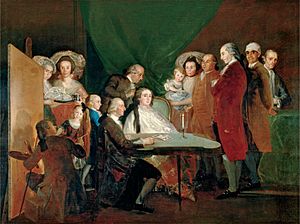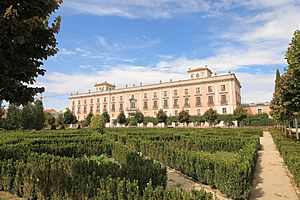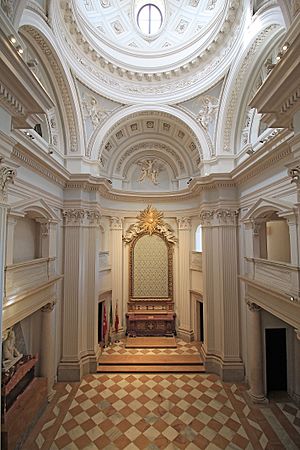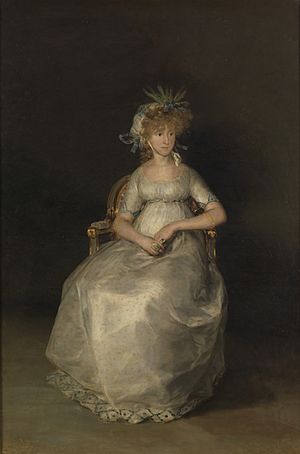Palace of Infante don Luis facts for kids
Quick facts for kids Palace of Infante don Luis |
|
|---|---|
| Native name Spanish: Palacio del Infante don Luis |
|
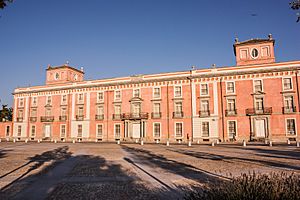 |
|
| Location | Boadilla del Monte, Spain |
| Architect | Ventura Rodriguez |
| Official name: Palacio del Infante don Luis | |
| Type | Non-movable |
| Criteria | Monument |
| Designated | 1974 |
| Reference no. | RI-51-0003950 |
The Palace of Infante don Luis (known in Spanish as Palacio del Infante don Luis) is a beautiful building in the Neoclassical style. It is located in Boadilla del Monte, a town near Madrid, Spain. This grand palace was built between 1763 and 1765. In 1974, it was officially recognized as an important historical site.
Contents
History of the Palace
The idea for this palace came from Infante Luis of Spain. An "Infante" is a title given to a son of the King of Spain, who is not the heir to the throne. Luis was the youngest son of King Felipe V and the brother of King Carlos III.
In 1761, Infante Luis took over the land of Boadilla. He bought it from Josefa Micaela de Mirabal, who was the 3rd Marquise of Mirabal. She was having financial difficulties at the time.
The palace you see today was built on the site of an older palace called the "Palace of the Two Towers." This older palace was part of the marquisate's home. The famous architect Ventura Rodríguez designed the new palace in 1763. The construction happened very quickly. The building was mostly finished by 1765. A special stone on the main front of the palace shows this completion date.
The palace was the main home for Infante Don Luis from 1765 to 1776. After that, he moved to another palace in Arenas de San Pedro. This was because he had a special kind of marriage, called a "morganatic marriage," with María Teresa de Vallabriga. This meant his children from this marriage could not inherit his royal titles.
Many important people lived or stayed at the palace. One famous person was the musician Luigi Boccherini. He was protected by the Infante during his time in Spain. For many years after, the palace belonged to the Infante's descendants, who were the Dukes of Alcudia and Sueca.
During the Spanish Civil War (1936-1939), the palace was badly damaged. Many valuable artworks were also lost. In 1974, it was declared a National Monument. In 1998, the local government of Boadilla del Monte bought the palace from its last private owner. This owner was Enrique Jaime Ruspoli Morenés. The city council planned to use the palace as a center for higher education and communication.
Palace Design and Features
Outside the Palace
The palace has a long, rectangular shape, about 17 meters wide and 80 meters long. The main entrance faces northwest, and the back of the palace faces the gardens to the southeast. The total built area is very large, covering over 6,300 square meters.
The building has three main sections, each with three floors. On each side, there are two smaller sections that are only one floor high.
The main materials used to build the palace are red brick and stone. The stone was used for the doorways, the triangular parts above the doors (called pediments), and the base of the building (called the socle). This base is made of large, cut stones called ashlars, which are made of granite. The roofs are covered with traditional Arabic tiles.
At each end of the roof, there are two small towers. These towers remind us of the original "Palace of the Two Towers" that stood here before. They are square-shaped and have oval openings that let in light.
The two main fronts of the palace are quite flat. The only parts that stick out are the doorways, the pediments, and the top edge (called the cornice). Above the cornice, there is a low wall that hides the roof. These two main fronts are the northern one, which is the entrance, and the southern one, which looks out onto the gardens.
The central entrance has columns in the Tuscan order. Above this, there is a balcony with Ionic columns. Then, there is a rounded pediment. Above that, a stone tablet says "A.D. MDCCLXV," which means the palace was finished in the year 1765. The other doorways on the sides also have balconies with triangular pediments.
There are not many decorations on the outside of the palace. Most of them are at the very top. You can see different vases and two coat of arms (symbols of King Felipe V of Spain). These are made of white stone from Colmenar de Oreja.
Inside the Palace
While the outside of the palace looks simple, the inside was very grand and luxurious. The chapel, in particular, was very impressive.
Inside, you would see many Corinthian style decorations. Expensive materials like marble, bronze, and stucco (a type of plaster) were used. The arches, corners (called pendentives), cornices, and ceilings (called vaults) were decorated with garlands, angels, grapes, and flowers. This shows how richly decorated this part of the palace was.
The chapel also contains the tombs of important historical figures. These include María Teresa de Borbón and Vallabriga. She was the second daughter of Luis Antonio de Borbón and the wife of Manuel Godoy. Also buried there is María Luisa de Borbón y Vallabriga, who was the Duchess consort of San Fernando de Quiroga.
The palace once held a very important collection of art. This collection belonged to the Dukes of Alcudia and Sueca. It included paintings by famous artists like Goya, Rembrandt, Murillo, Velázquez, and Dürer.
Gardens and Grounds
The palace was built on a large piece of land, covering over 71,000 square meters. This land was designed as a beautiful garden complex with a regular layout. Because the land was uneven, the gardens were arranged in different levels, or terraces, connected by stairways. There was also a wild park area that blended the palace gardens with the natural countryside.
The gardens were designed with a clear Italian influence. They spread out from the southern side of the palace. They are divided into two main areas: the high garden and the low garden, separated by two walkways.
Both garden areas had many beautiful decorations. These included three caves, a pond, a stone bridge, and a Ferris wheel, which can still be seen today. Another famous feature was the Fuente de las Conchas (Fountain of the Shells). This fountain was designed by Ventura Rodríguez and sculpted by Francisco Gutiérrez Arribas and Manuel Álvarez. It was originally located near the back of the palace.
However, in the early 1800s, the Infante's heirs gave the fountain to King Ferdinand VII and his wife María Cristina. It was then moved to the Royal Country Estate of Vista Alegre. In 1845, this beautiful fountain was moved again. It is now displayed in the Campo del Moro gardens, next to the Palacio Real de Madrid (Royal Palace of Madrid).
Near the main entrance of the palace, on the northern side, there is another fountain. It is called the Ventura Rodríguez Fountain, or the Tres Caños (Three Spouts) Fountain. This fountain was also designed by Ventura Rodríguez. It has three arched sections and flat columns (called pilasters) in the Tuscan style. This fountain used to be the center of a landscaped area. However, this area disappeared as Boadilla del Monte grew, and now a street and a square are in its place.
The entire palace grounds are surrounded by walls made of lime and brick. On top of these walls, there is a decorative railing (called a balustrade) made of white stone. You can enter the grounds through four Neoclassical gates. These gates are made of brick and topped with triangular pediments, though they are quite old and worn now.
See also
 In Spanish: Palacio del Infante don Luis (Boadilla del Monte) para niños
In Spanish: Palacio del Infante don Luis (Boadilla del Monte) para niños


